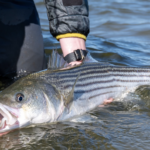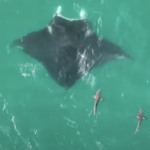
Talkin’ Striped Bass Spawn Dynamics
Consistent spawning production is paramount to a fishery’s long-term health. Many environmental factors are suspected
By Will Poston, Fisheries Policy Consultant
A Congressionally mandated, 200-plus page study that mentions “red snapper” 297 times could only come from one piece of legislation: The Modernizing Recreational Fisheries Management Act of 2018, or “Modern Fish Act” for short. This legislation was fueled in part by growing frustration among anglers and some recreational fishing organizations in the Gulf of Mexico who wanted to harvest more red snapper in federal waters. Initially an attempt to increase recreational allocations and potentially weaken the need for recreational fishermen to adhere to core conservation provisions of the Magnuson-Stevens Act (such as Annual Catch Limits and accountability measures), the Modern Fish Act was eventually watered down, largely to mandates for a few reports and studies.
Section 202 of The Modern Fish Act directed the National Academy of Sciences (NAS) to determine how the NOAA Fisheries Marine Recreational Information Program (MRIP), which collects saltwater recreational fishing catch and effort data, could be improved to better meet the needs of in-season management for fisheries managed under Annual Catch Limits (ACLs). In addition, NAS was directed to explore potential alternative management strategies for the recreational sector.
The study, a multiyear effort by a panel of experts that included several meetings to gather information from fishery stakeholders, culminated in a final report released last week, entitled Data and Management Strategies for Recreational Fisheries with Annual Catch Limits. ASGA’s Executive Director, Dr. Willy Goldsmith, was among the nine peer reviewers who provided technical input on the study prior to publication. We’ll try to distill the key takeaways from this Herculean effort in the paragraphs below.
In-season management is a tremendously resource-and data-intensive method for managing fisheries, but it provides significant benefits. Most notably, in-season management can efficiently constrain recreational fisheries to their annual catch limits (ACLs), a notoriously difficult activity for fishery managers. The idea behind in-season management is to constantly have “a finger on the pulse” of the fishery: At any given point in the fishing season, managers know how many fish have been caught and can track progress toward reaching (but not exceeding) annual limits—a capability that already exists in commercial fisheries.
Recreational catch and effort data, however, are inherently more difficult to estimate in a timely and efficient manner. Think about how many thousands of people fish, with a broad diversity of skill levels and motivations and departing docks, plying fishing piers, scouring beaches…you name it. To put a finer point on it, according to NOAA Fisheries, it’s estimated that recreational anglers took nearly 200 million trips and caught nearly 1 billion fish in 2019. The magnitude of recreational fishing activity complicates data gathering, but MRIP remains effective at generating annual recreational catch and effort estimates for fish species at a coast-wide level and is still the best available science at that scale. However, when zooming into more specific data with regard to geography, timeframe, catch type (harvest or releases), and mode (e.g., shore, charter boat, or private/rental boats), MRIP can be less precise, which often draws the ire of disgruntled stakeholders.
In its current form and implementation, the authors acknowledge that MRIP cannot support in-season management, as it was neither intended nor designed for that purpose. In fact, a 2017 NAS study on MRIP came to the same conclusion. However, a primary objective of the current study was to identify ways to improve MRIP to better facilitate in-season management of recreational fisheries with ACLs.
How to Improve MRIP for In-Season Management
In-season management requires data with high levels of timeliness and precision. MRIP releases its estimates every two months in “waves,” as they’re formally referred to. The study found, however, that MRIP could shorten the time for releasing estimates to monthly, but any benefits would be “modest” and “not likely to justify the costs.” Instead, the Committee recommends:
Alternative Management Approaches
The study discusses a wide range of alternative management approaches for recreational fisheries with ACLs, including voluntary and mandatory reporting of harvest, permits and stamps to track participation and effort, harvest tags, and depth/distance-based management. The key in all of these approaches—it’s worth saying again—is that they’re all subject to the backstop of a hard Annual Catch Limit to ensure overharvest doesn’t occur. Each alternative approach has benefits and challenges. For example, voluntary reporting programs can produce useful information, but participation in these programs is universally low. The study highlights the value of mandatory reporting programs and encouraged further exploration of this strategy (ASGA is currently working to improve mandatory self-reporting rates in the recreational bluefin tuna fishery, but more on that to come in a subsequent blog).
Ultimately, the study recommends the following approaches for pilot testing:
In closing, this study reaffirms some key ideas and rules. Recreational fisheries are difficult to manage, and recreational catch is even harder to estimate. Discovering innovative approaches to overcome those challenges and sustainably manage all our fisheries, is a no brainer. However, these new management approaches and MRIP improvements must remain compliant with MSA’s requirement for science-based ACLs to prevent overfishing. We’re appreciative of the authors’ efforts in assembling this comprehensive report and look forward to working with scientist and managers to help develop and implement some of the study’s recommendations.

Consistent spawning production is paramount to a fishery’s long-term health. Many environmental factors are suspected

While the ASGA team is extremely proud of the community we’re building with the Guide

Feature Image: A false albacore being landed off Jupiter Florida by the Cheeky Fishing team,

Feature Photo: “Best Practices for Fishing Cobia Around Manta Rays” The Florida Manta Project is
We rely on our members and donations to keep fighting for a sustainable tomorrow in marine conservation.
By using this website, you agree to our use of cookies. We use cookies to provide you with a great experience and to help our website run effectively. To learn more, please review our privacy policy.
2 Responses